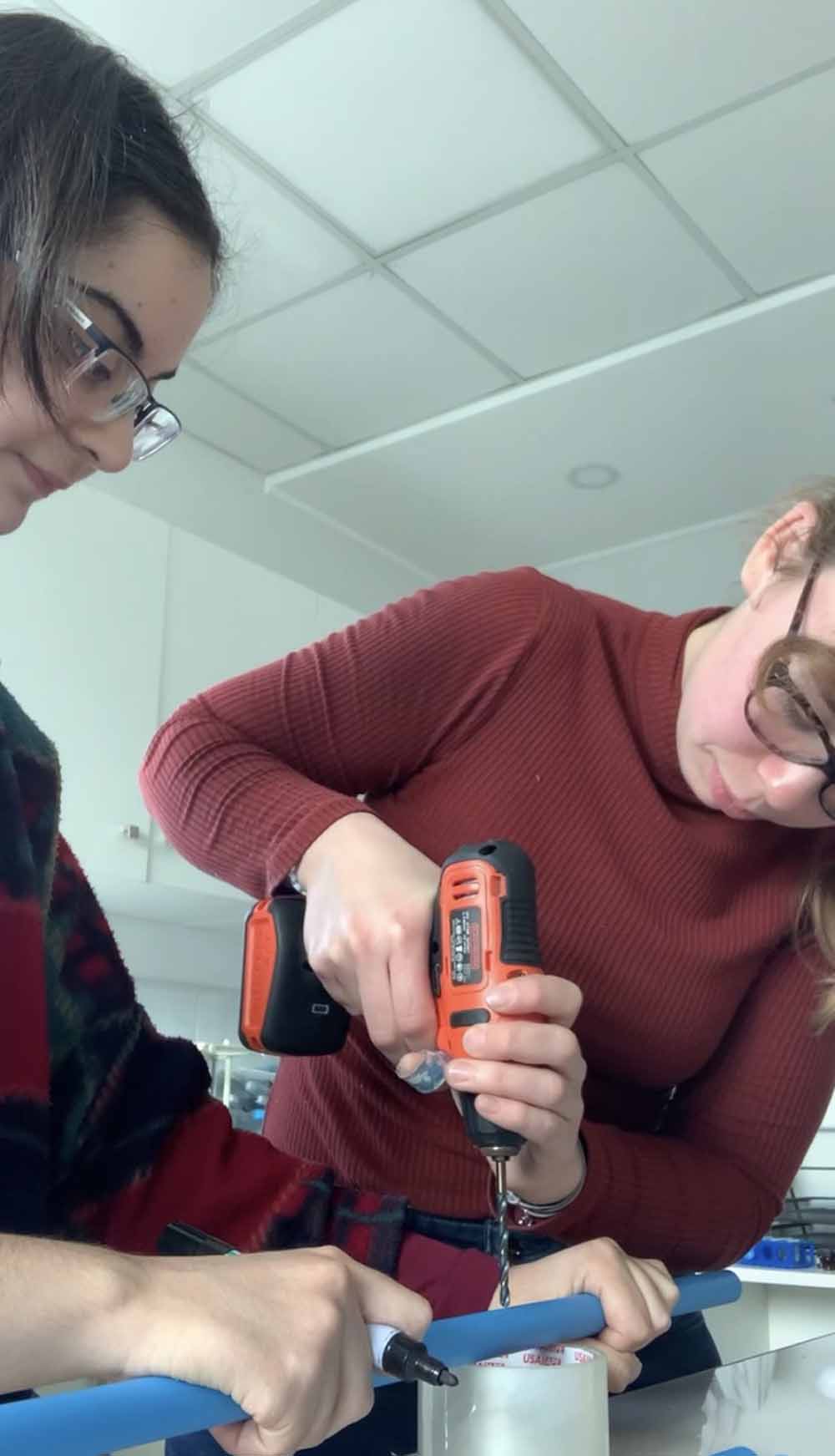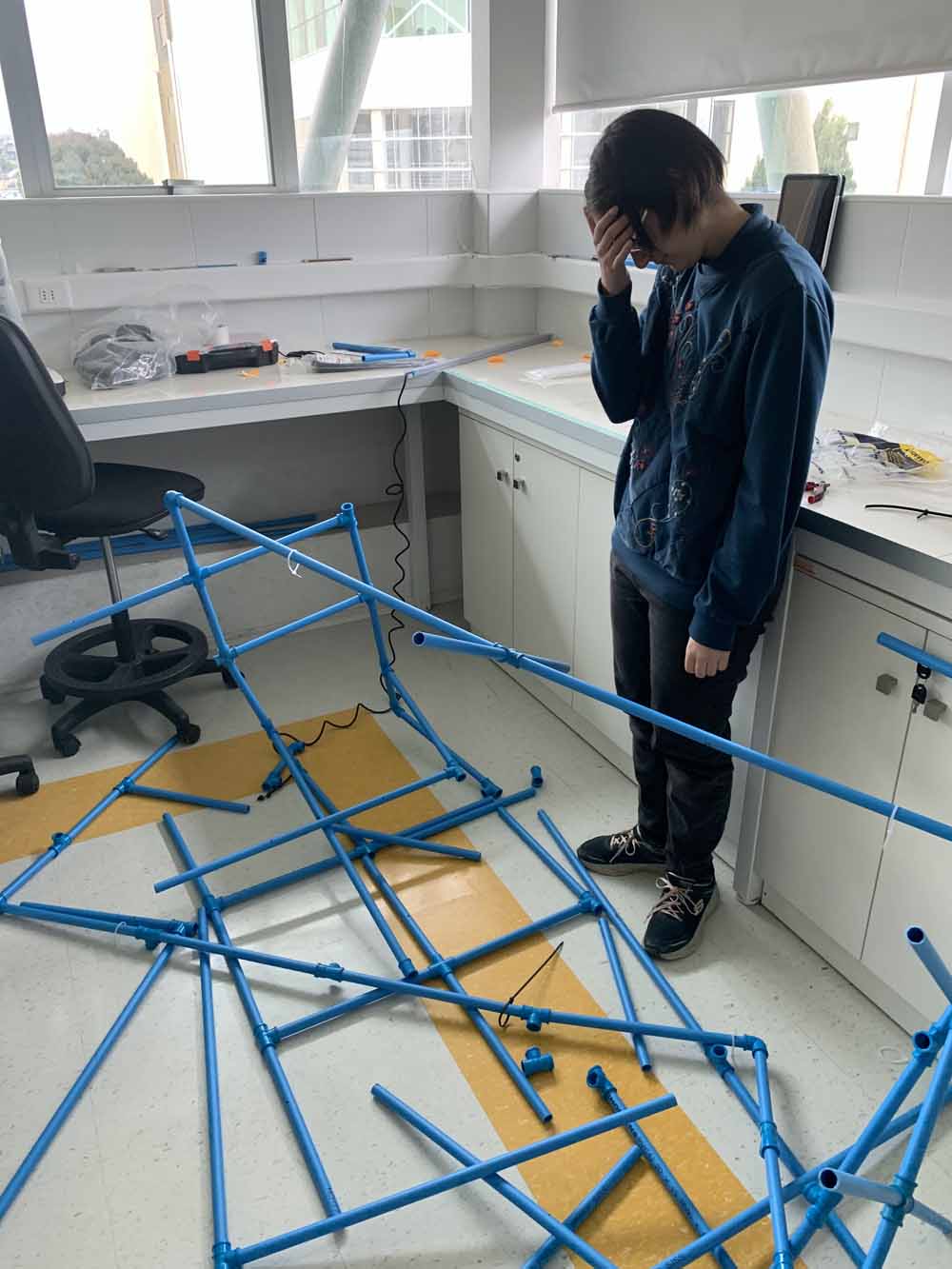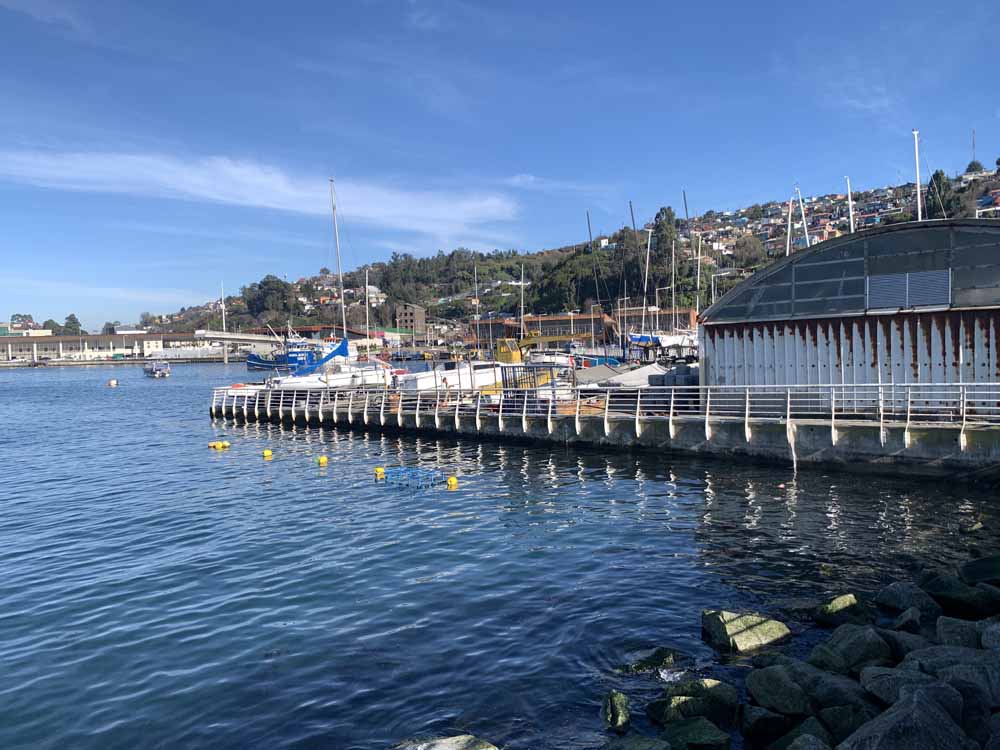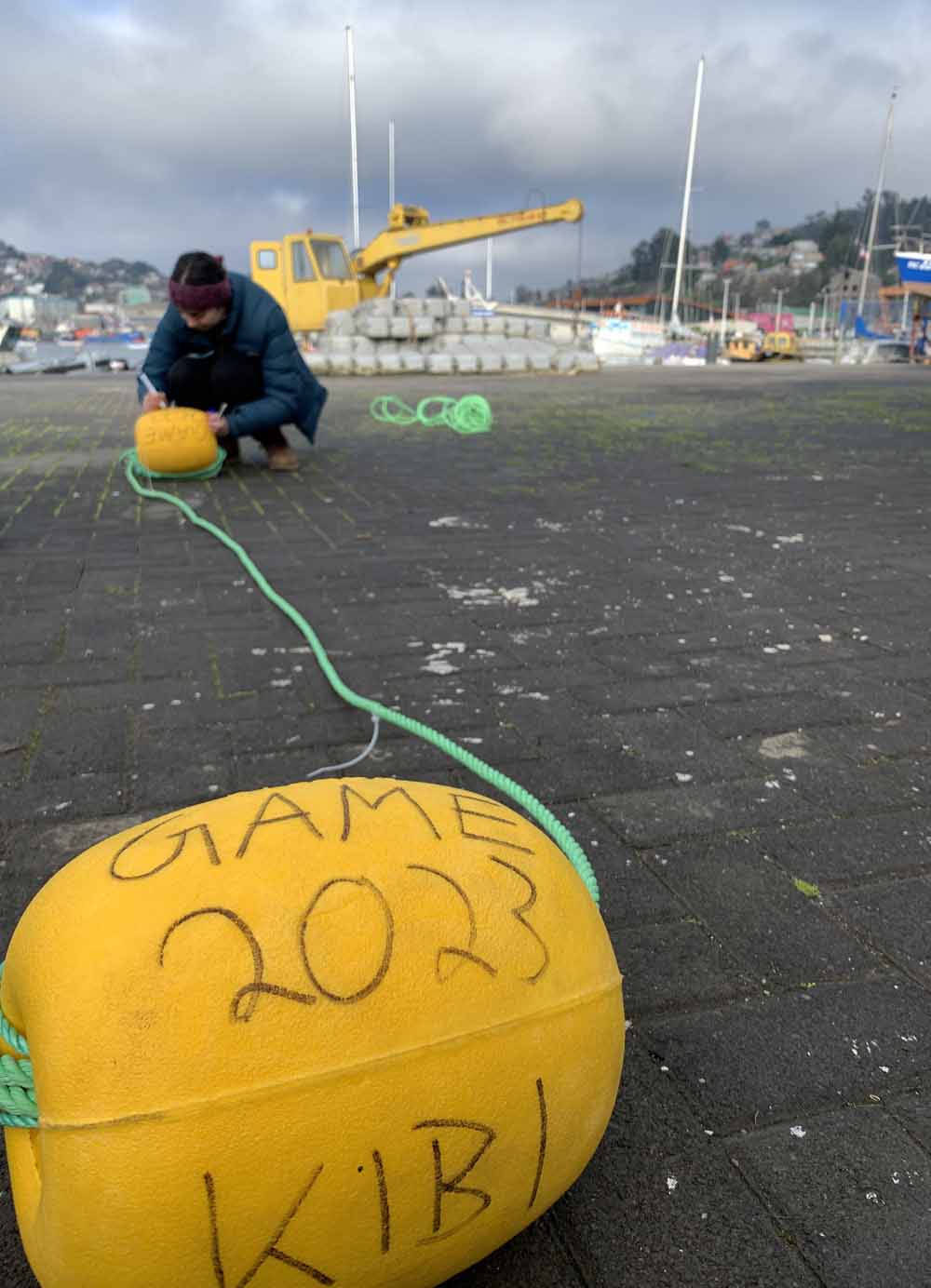Snorkelling through colourful coral reefs, diving into the deep unknown, and cruising through ice and snow on research vessels such as Polarstern. These are activities that most of you will probably expect if you hear that we are budding marine biologists. And honestly, this is also what we had in mind when we started pursuing this career path. But on many days, our work looks vastly different, just as in this year’s GAME project. So let us take you on a journey behind the scenes of our everyday scientific life, the life of Team Chile: Gabi from Universidad Austral de Chile in Valdivia and Kira from GEOMAR in Kiel.

Gabi: Kira and I met in March for the GAME preparation course in Kiel. I was told that it was almost spring in the north of Germany, but the harsh wind and lack of sunlight took some credibility away from this assessment—there were even a few snowy days sprinkled around.
When we met again in April, it was already autumn.
Only a few days had passed since our departure from Kiel, but we were across the ocean and in the opposite hemisphere. In the same way, Kiel’s alleged early spring looks to me like winter, autumn in Concepción is like the weather you’d expect from an equatorial rainforest—except at lower temperatures. It’s sunny and warm in the morning, then windy and grey in the afternoon, it might be foggy in the evening, and it may also rain a bit from time to time throughout the day. People here also call this place “Tropiconce”. Lovingly, with a tinge of annoyance.
Kira arrived first and I followed a week later. We grouped together the next day and met up with (Dr.) Iván Hinojosa, our supervisor, guide, and treasurer of the GAME funds. It was a strategy meeting. Ideas were discussed, discarded, and elaborated, until we had a basic set-up design in mind and all over the drawing board. Before parting ways, Iván handed to us 100.000 CLP (~110 €) and said to us “Play!” So, we went to the local Hidrocentro—a plumber’s dream store—to buy PVC tubes and then to the Sodimac—Chilean Bauhaus, as I’m told—, and we started playing.
Kira: In this way, during our first months in Chile, we frequently found ourselves wandering through the aisles of DIY stores wondering which materials are suitable for building our experimental set-up. The latter is an enormous PVC frame, which is carrying our precious PVC settlement panels while they are submersed in the sea. This frame consists of numerous PVC tubes of different lengths that are connected by various PVC fittings. As you may have noticed, PVC is the most important material in our experiment and even though we are actively fighting plastic pollution as scientists, ironically no other material is more suitable for ecological experiments with macroinvertebrates in marine habitats than plastic. It floats, at least when there are air filled cavities, and it is robust and rust-proof. These characteristics are essential for building an experimental set-up that is supposed to withstand strong wave action, UV-radiation and saltwater while being exposed in the sea just below the water surface.

Gabi: Building our frame felt like playing with Legos for the first two or so tries. We used a tailor’s measuring tape and a handsaw to mark and cut the PVC tubes, which were sold in a convenient 3 m format. We connected them with PVC tees, elbows, and crosses; and then prototype 1.0 was done.
Iván touched it a bit roughly and it quickly crumbled down.

For prototype 1.1 we learned to stick the measuring tape to the table with Scotch-tape and we added a few more PVC pillars to the design. Iván pushed it some and it lasted a respectable minute before falling apart. For prototype 1.2, we started using guides to cut and sand the tubes, prototype 1.3 got draining holes and an elastic rope skeleton. We followed with a fancy garden mesh to support our panels, added weights and floaters, and a bunch of cable ties. All along, we started borrowing skills, cheats, and tricks that are more akin to engineering than to marine biology. By the time PVC glue got involved, we were already swimming in microplastics from all the adjustments and re-adjustments, cuts and more cuts. We finally took this hulk of a prototype to the water and named it “El Percebe Feo” (The Ugly Barnacle).
However, El Percebe still needed to pass many trials for different scenarios, otherwise our experiment wouldn’t withstand the winter.

Kira: For testing the frame’s stability and its floating abilities, we went on a trip to our natural habitat: the sea. At the marine biological station in Lenga, we put on comfortable wet suits as the water temperature during wintertime in Chile drops to below 10 °C. Yes, you are right in assuming that we are the only team of this year’s GAME cohort that is crazy enough to conduct a marine field experiment during the winter. But don’t worry, our wet suits are pretty efficient in keeping us warm. Thus, we discovered that our frame needs some more buoys to ensure that it is floating and keeping the settlement panels at the desired water depth.
Obviously, it is impossible for marine biologists to go into the water without taking even a short look at the local wildlife. So, of course, exciting underwater experiences are also part of our work life from time to time. In Lenga, we seized the opportunity and snorkelled along the rocky shore. As large parts of the Chilean coast are located in an upwelling system, the waters around Lenga are rich in nutrients. They ensure the thriving of beautiful brown, green and red algae all-year-round, which serve as delicious food for the marine fauna. We were able to marvel at gigantic sea stars, colossal mussels, and snails as well as tremendous crabs during our snorkelling trip. To our uttermost excitement, we spotted the famous “Pintarroja”, a Chilean cat shark species, and an octopus which even changed its colour while hiding from us curious humans. Thus, even though we found out that our frame still needs some improvements, the trip to Lenga was a raving success.
Gabi: For the final destination of our frames, we had several options: Lenga, Coliumo, Talcahuano-Marina and Talcahuano-Cendyr.
Lenga had the advantage of being near the University’s (Universidad Católica de la Santísima Concepción) marine research station. But it was discarded because it was too exposed and researchers who had worked there before, also with settlement panels, had lost some of them to the unrelenting waves. Coliumo was also dropped for similar reasons. Talcahuano-Marina belongs to a military station and Kira would have to keep outside due to the justified concern of her being a wicked foreign spy, not to mention the paperwork, so it was kept more as a last resort type of option.
The Cendyr Náutico Talcahuano, a space administered by the Talcahuano’s Municipal Corporation of Sport and Recreation (Corporación Municipal de Deporte y Recreación de Talcahuano), is a place that offers multiple watersport courses, such as windsurfing and navigation. Now it is also a host for marine research. However, although the people at site were very welcoming, the bureaucratic procedure to get the green light was not.
We submitted our petition at the municipality and were told to wait one week. We went back the next week. We followed our petition to the assigned department; we were told to call the next week. We called the next week, we were derived. We called again; our petition was misassigned. The secretary gave us the contact of another department’s secretary. The secretary told us to send the petition again as an email. We then got an appointment of, give or take, one hour that finished with a handshake and the green light.

With the green light to deploy our set-ups in Talcahuano, we were free to burn the budget. We bought all the materials to build four frames from thre scratch and to start the preparations for connecting the LEDs to the electric line power supply. Although, I could sense some curiosity from the sales people at Hidrocentro, nobody questioned what two young women needed 17 hydraulic PVC tubes of 6 m cut in half for. The lady at the cordonery shop was less shy, and politely asked us what we were going to do with 150 m of elastic rope.
Iván and Víctor, a Master’s student who is also working with Iván, helped us to install a line and we left El Percebe at site to see how it fared against the tides.

That same week a front of bad weather struck and flooded a huge part of the country, including our region.
But El Percebe persisted and came out entirely intact. Nonetheless, tree branches as long as myself had been dragged by the increased river flow from further inland all the way to our deployment area—later, we would clear out two full boatloads of branches with the help of Cristian, an instructor at the Cendyr.

Meanwhile, we rushed to finish our four definite cages before the end of June. Because the frames were too big to be transported all at once, we had to pre-build them in the lab at the university and to finish assembling them at site. Just like an Ikea coffee table. Although, the process of assembling one of our frames isn’t difficult per se, it is inevitably time consuming.
For example, to add floaters to the frame you need to fit one or two of them through a rope—previously cut and sealed with fire at both ends—and tie it with clove hitch knots to the frame. Repeat the process for 28 floaters—about 64 knots—per frame, and then finish it off with a cable tie in each floater placed in such way that it secures the knot from undoing for some extra protection. Even if you work as efficiently as possible, only this process could easily take up to three hours; twelve hours considering all four frames. Adding up other parts of the assembly process, each cage meant an assembly time—without accounting for pre-preparation, i.e cutting up and sanding the PVC tubes—of 9 to 12 hours.
The Cendyr works in a weekday schedule of 9:00 to 18:00 so we didn’t have any time to spare. Two holidays were missed, weekends felt like Wednesdays and food was delivered to the lab at 23:00 pm in anticipation of one of our roughest shifts. Suffice to say we refer to this period of time as hell week instead of deployment week.
But hey! We did it! We deployed all four frames just in time, the system worked and now we wait for biweekly and monthly panel sampling (Another storm hit us up two days after deployment, albeit not dragging as many branches as the previous one. Our frames held up like champs, light system included. Hopes are high for them).
Kira: We were excited to deploy our frames and to see which of the gigantic species that we saw during our snorkelling trips will recruit on our settlement panels – under the influence of artificial light at night or without this influence. If you are just as curious about the developments of our experiment and of the experiments of the other GAME teams as we are, stay tuned: In the following weeks you will probably witness how Team Japan is doing.
